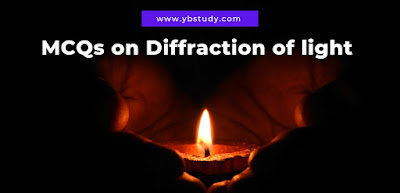Multiple Choice Questions on diffraction of light
Multiple Choice Questions on diffraction of light :
Diffraction: The phenomenon of bending of light around the corners of an obstacle or an aperture into region of geometrical shadow of obstacle is called diffraction of light. According to rectilinear propagation, light travels in a straight line. Italian scientist Grimaldi discovered that the light bends near the edges of the aperture obstacle whose size is comparable with the wavelength of light and enters the geometrical shadow. Diffraction of light can be observed only with obstacles or apertures of very small size. When a small obstacle (opaque material) or an aperture (small opening) is placed infront of monochromatic source of light then the geometrical shadow is produced. Some of light bends into the region of geometrical shadow and its intensity falls off rapidly.
This bending of light is extremely small when the wavelength of light is small as compare to the dimension of obstacle or aperture. Because of diffraction, the edges of the shadow or illuminated region do not remain well defined and sharp, but become blurred and fringed.
Multiple Choice Questions on diffraction of light
1. In a single slit difiraction pattern intensity and width of fringes are__________
(a) unequal width
(b) equal width
(c) equal width and equal intensity
(d) unequal width and unequal intensity
Answer: D
2. Which one of the following is most essential for observing diffraction of light___________
(a) monochromatic light
(b) white light
(c) a very narrow slit or obstacle
(d) two coherent sources
Answer: C
3. If white light is used in diffraction due to a slit, the central maxima will be__________
(b) white
(a) black
(c) coloured
(d) red
Answer: B
4. A diffraction pattern is obtained using a beam of red light. What happens if red light is replaced by the blue light_________
(a) bands disappear
(b) diffraction bands become narrow and crowded together
(c) diffraction bands become broader and farther apart
(d) no change in diffraction pattern
Answer: B
5. A small circular disc is placed in the path of monochromatic light. The centre of the geometric shadow is always_______
(a) bright
(b) dark
(c) coloured
(d) half bright and half dark
Answer: A
6. If a wavelength of a wave is large, then the degree of diffraction observed is__________
(a) Less
(b) More
(c) Zero
(d) Data insufficient
Answer: B
7. The angular width of the central maxima of a diffraction pattern due to a single slit does not depend upon the________
(a) distance between slit and source
(b) width of the slit
(c) wavelength of light used
(d) frequency of light used
Answer : A
8. The main difference in the phenomenon of interference and diffraction is that_________
(a) diffraction is due to interaction of light from different parts of same wavefront, whereas the interference is the interaction of two different waves derived from the same source.
(b) diffraction is due to interaction of light fromm the same wavefront whereas interference is the interaction of waves from two isolated sources
(c) diffraction is caused by reflected waves derived from the same source, whereas interference is the bending of light from the same wavefront
(d) diffraction and interference both are due to interaction of light from different parts of same wavefront
Answer: A
9. The phenomenon of diffraction may be considered as interference, where the number of coherent sources are_______
(b) one
(a) zero
(c) less than 5
(d) infinite
Answer: D

